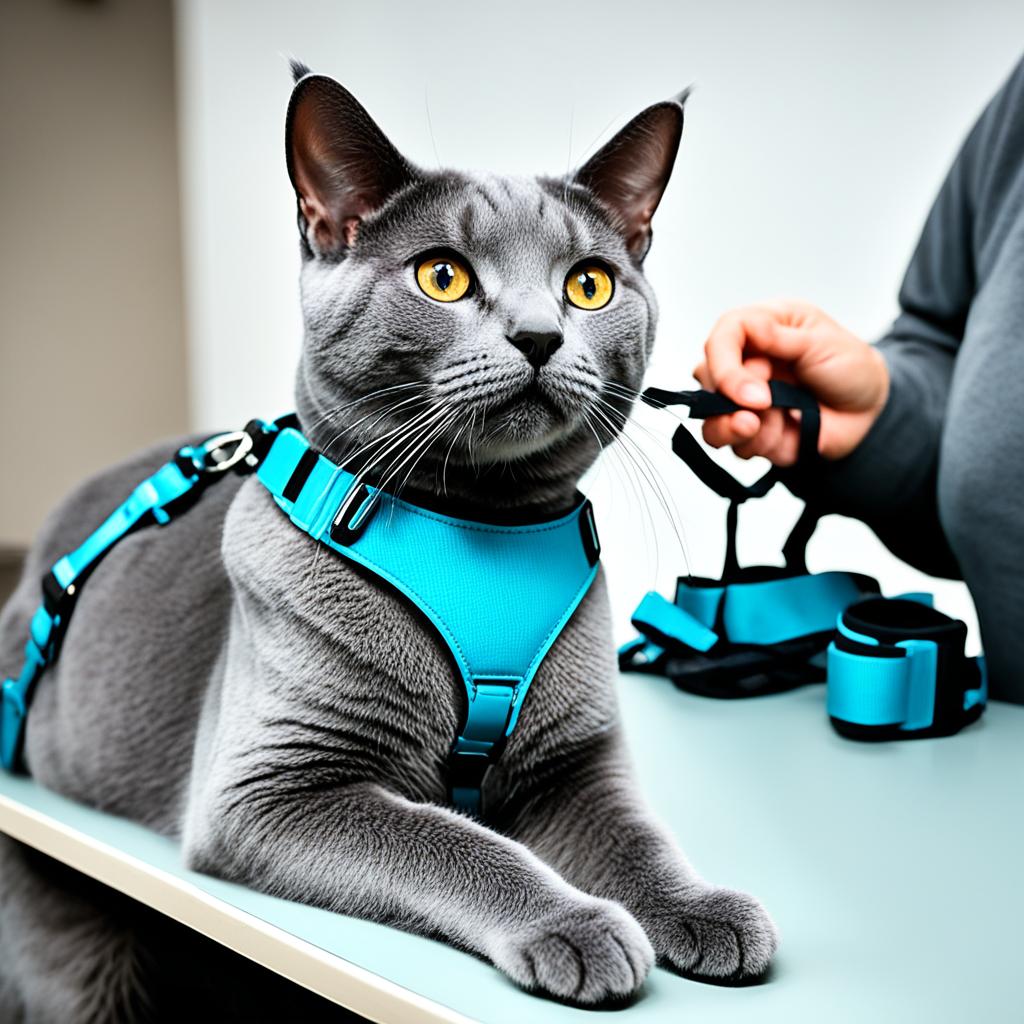Have you thought about taking your indoor Russian Blue Cat outside, like adventurous dogs? The good news is you can. With the right methods and patience, your Russian Blue can learn to love wearing a harness and going outdoors.
Take your cat on an exciting journey into the world of outdoor fun. Training your cat to use a harness will be an adventure of its own. It will go from the first time they plop on the floor to confidently walking outside. Advice from experts in cat harnesses and walking will help. They can guide you on turning your indoor cat into an outdoor enthusiast.
Key Takeaways
- Harness training combines patience with the thrill of outdoor exploration for your Russian Blue.
- Expect initial resistance but anticipate rewarding, confident strolls.
- Expert advice from cat harness boutiques can significantly aid your training endeavors.
- Your journey from a ‘flop to the floor’ to confident walks is part of the process.
- Harness training enriches your cat’s life, ensuring safety while exploring the outdoors.
- Ensuring the right fit and comfort for your cat’s harness is crucial for successful training.
Understanding the Russian Blue Cat’s Temperament

The journey of harness training your Russian Blue Cat begins with understanding their unique temperament. Originating from the grand Archangel Isles of northern Russia, these blue-coated beauties were adored by Russian Czars for their sweet-tempered demeanor and unwavering loyalty. Their intelligence is remarkable, making them quick learners but also requiring a rich balance of social interaction and solitude.
When it comes to Russian Blue Cat behavior training for harness use, you’re dealing with a cat that craves affection but also appreciates its personal space. This means you need to approach harness training with patience and insight into their behavioral cues.
Training this breed to use a harness can be both a challenge and a joy. Their calm and composed nature often makes them hesitant to accept new experiences. But with a step-by-step guide for harness training a Russian Blue Cat, you can gradually introduce them to this new world of exploration.
In essence, knowing the temperament of your Russian Blue is key to successful harness training. Their loyalty and intelligence, coupled with a need for affection and occasional solitude, make them an intriguing yet adorable training subject. By grasping their behavioral patterns, you’re well on your way to making harness training a mutually enriching experience.
Choosing the Right Harness for Your Russian Blue Cat

Starting harness training with cats is fun and important. The right harness keeps a Russian Blue safe and comfy on trips.
Features to Look for in a Harness
- Adjustability: It’s important the harness fits snugly. Find one with adjustable parts for a custom fit.
- Material: Choose a harness made from light, strong material. Breathable mesh is a good choice.
- Secure Closures: Make sure the harness closes securely, with buckles or Velcro tough enough for little pulls.
- Reflectivity: For safety at night, pick a harness with reflective bits.
How to Properly Fit the Harness
Fitting a harness right is the first step. For Russian Blues, a smooth fit is key to comfort.
- Measure Twice, Buy Once: Measure your cat’s chest and neck girth right. Use brands’ size guides to find the perfect one.
- Initial Adjustment: The first time, make the harness a bit loose. This eases your cat into it without shock.
- Gradual Tightening: Each day, make the harness tighter till it fits perfectly but not tight.
- Check Mobility: Make sure your cat can move freely. They should walk, sit, and play without problem.
Be patient as you do this. Envision your Russian Blue strutting with its harness. It will all be worth it.
How to Train a Russian Blue Cat to Use a Harness?

The journey to train a Russian Blue Cat starts indoors. This is key for future fun outside. They need to feel safe and happy. To teach them about harnesses, be patient and smart.
Initial Training Indoors
Start with the harness in a quiet spot. Let your cat check it out. Then, gently put it on them. Keep it brief and positive. Giving treats and praise helps make the harness a friend.
Encourage Movement with Treats and Toys
Next, get your cat moving in the harness. Use treats and toys to lure them. Playtime keeps them happy and forgetful about the harness. Thus, it’s a fun step in training.
These first few steps are crucial for a Russian Blue Cat and their harness. Use treats wisely – not just for rewards, but as encouragement. Toys that move like prey are good too. As they get used to the harness more, make it part of a fun activity. This all prepares them well for adventures outside.
Using a Cat Backpack to Aid Training
Harness training a Russian Blue can seem tough. But, a cat backpack makes it easier. This method helps your cat get used to the outdoors. It also gives you peace of mind. Here’s how to use a cat backpack effectively for training.
Getting Your Cat Comfortable with the Backpack
Start indoors with the backpack. Put it in your cat’s favorite spot. Then, add some yummy treats inside. This creates a good link between the backpack and good things. With time, treats, and toys, your cat will find the backpack safe and fun. This is key in *How to Train a Russian Blue Cat to Use a Harness*.
- Place the backpack in a familiar space.
- Encourage your cat to explore it with their favorite treats.
- Gradually increase the time they spend inside the backpack.
Advantages of a Cat Backpack
A cat backpack has many pluses beyond training. These backpacks are cozy and safe. They let you take your cat on trips without the fear of being stressed. Plus, in emergencies, your cat’s backpack familiarity can save the day.
- Security: Ensures that your cat is safe and comfortable while adjusting to new surroundings.
- Convenience: Easy transportation during trips to the vet or outdoor explorations.
- Safety: In emergencies, a familiar backpack can prevent panicked escapes.
By following these *Tips for training a Russian Blue Cat with a harness*, and using a backpack, your training and outdoor trips will be better. As a result, every walk will be safe and fun for you and your cat.
Slow and Steady: The Key to Successful Harness Training

If you want to train your Russian Blue to wear a harness, go slow. Remember, “slow and steady wins the race” here. Patience is key. Following a step-by-step guide for harness training a Russian Blue Cat is best. This way, you can be calm and consistent, leading to good results.
Start the harness training inside. Let your cat get used to the harness in short bits at first. This way, they won’t see the harness as something scary. Making friends with the harness slowly is very important. It helps your cat stay relaxed.
Next, focus on the 3 P’s: persistence, patience, and perseverance. These are key in leash training for Russian Blue Cats. Take your time with your pet. Let them guide when they’re ready. This helps them stay calm and feel safe.
- Persistence: Keep showing the harness to your cat, even if just for a few minutes each day.
- Patience: Be ready for challenges and small wins. The journey can be slow but it’s worth it.
- Perseverance: Keep your cat active and positive. Treats and toys can help keep up their interest.
Harness training takes time. Every step helps build your cat’s trust in you. Stick to the step-by-step guide for harness training a Russian Blue Cat. Playful training and a positive mood are crucial. Your cat will learn to enjoy the outdoors little by little.
Starting the Outdoor Experience

Going outside with your Russian Blue Cat can be an exciting adventure. To have a smooth journey, start by preparing well. This helps your cat transition easily from indoor spaces to the great outdoors.
Finding the Right Outdoor Spot
Pick a peaceful, safe place for your cat’s first outdoor trips. Stay away from loud or busy areas that might scare them off. Opt for calm parks or private gardens where your cat can enjoy exploring.
Timing the Outdoor Sessions
It’s important to choose the right time for your cat’s outdoor trips. Begin with short outings when it’s calm, like in the morning or late afternoon. As your cat gets used to it, extend these trips. This helps them remain calm and enjoy their time outside.
These strategies set the stage for a fun outdoor journey. Keep in mind, training your Russian Blue Cat takes time and effort. Be patient and persistent. Enjoy the adventure together!
Handling Common Issues During Harness Training

Harness training your Russian Blue Cat can be challenging but rewarding. They might resist or try to escape, but don’t worry. With *consistent, positive reinforcement*, you can overcome these challenges. Here’s a guide to deal with common issues.
“One day your Russian Blue will figure out the harness is a key to outdoor adventures. Trust the process!”
- Unexpected Escapes: Make sure the harness fits well. It should be snug but not too tight. This helps prevent any escape attempts.
- Reluctance: Let your cat check out the harness on their terms first. Use treats and praise to make them like it more.
Patience is key in training your Russian Blue Cat with a harness. Begin indoors, slowly getting them used to the harness. Stay calm if they resist and offer positive rewards like treats and engaging toys. Check out these pro tips for harness training:
- Gradual Introduction: Let your cat explore the harness at their own pace.
- Reward-Based Training: Use tasty treats to show wearing the harness is a good thing.
- Short Duration: At first, keep the harness on for just a few minutes, then increase the time slowly.
- Calm Environment: A quiet space free from distractions is best for training.
Always keep safety in mind. Don’t leave your cat alone while they’re harnessed. Also, avoid busy or noisy places at first. Early identification of any issues helps make training smoother for both of you.
Consistency matters when training with a harness. Short, regular sessions are better than long, sporadic ones. While it might be tough, nothing beats the joy of outdoor adventures with your beloved Russian Blue.
| Common Issues | Solutions |
|---|---|
| Unexpected Escapes | Ensure a snug fit and always supervise during harness training. |
| Reluctance | Use treats and praise to create positive associations with the harness. |
| Resistance to Movement | Employ toys and playful interaction to encourage movement while harnessed. |
| Overstimulation | Keep initial sessions short and in a calm environment. |
Using Toys and Treats to Enhance Training

Adding toys and treats makes Russian Blue Cat training fun. It turns what’s tough into something both enjoyable and rewarding. These items are key to showing your cat when they do good.
Recommended Treats for Training
Choosing the right treats is crucial for training your Russian Blue Cat. Pick tasty, small treats. Here are some favorites:
- Temptations MixUps Cat Treats: Cats enjoy this tasty mix.
- Blue Buffalo Bursts: Has a crunchy outside and a soft inside.
- Greenies Feline Dental Treats: Tasty and good for your cat’s teeth.
Engaging Toys to Distract and Lure
Toys are great for harness training too. They’re not just for fun; they help with moving around and getting used to the harness. Check out these top toy picks:
- Catit Senses 2.0 Circuit: Boosts hunting instincts with a track toy.
- Jackson Galaxy Air Prey Wand: Keeps cats active by mimicking bird flight.
- KONG Active Feather Teaser: Encourages play and harness exploration.
The right mix of toys and treats can make training your Russian Blue Cat easier and more fun. They keep your cat interested and make training a positive experience.
Monitoring Your Cat’s Health During Training

When you’re harness training for cats, watching your Russian Blue’s health is key. It ensures your cat is happy and ready for outdoor fun. Being careful and ready helps make the training successful.
Signs of Stress to Watch Out For
Stress can affect your Russian Blue without warning. Look for clues like lots of grooming, hiding, or meowing. These signs show your cat might feel uneasy. Knowing when to slow down training or give more love can prevent stress.
Importance of Vaccinations
Staying current on vaccinations is vital for your cat’s Russian Blue Cat health. Especially when they’re exploring new places. Visiting the vet for check-ups keeps them safe from outside dangers.
This care helps your cat stay healthy while they enjoy the outdoors. So, it’s a big part of their fun adventures.
Benefits of Harness Training Your Russian Blue Cat

Training your Russian Blue Cat with a harness has lots of good results. It goes beyond just a physical exercise. This training keeps your cat’s mind active and sharp. Also, it benefits their mood and how they behave.
Using a harness with your Russian Blue builds a strong bond. The first steps outside will grow your connection. This makes your cat a great friend who is interested and self-assured.
It’s not just about fun. Leash training also gives them power. They can explore new places outside. This makes their life more interesting with different smells and sights. It also helps them avoid being bored and making a mess at home.
| Benefits | Description |
|---|---|
| Mental Stimulation | Exploring new environments keeps them engaged and prevents monotony. |
| Physical Exercise | Regular walks ensure they stay fit and active. |
| Bonding Time | Shared experiences strengthen the bond between you and your cat. |
| Behavioral Improvement | Reduces boredom and destructive habits by offering a productive outlet. |
It doesn’t matter if you’re new to owning a cat or you’re experienced. The prove advantages of using a harness with your Russian Blue Cat are real. So, get your harness ready and start your adventure together!
Conclusion
Starting to train your Russian Blue Cat in a harness opens up so much fun and adventure outside. You’ve walked through each step and not only taught your cat to wear a harness but also how to enjoy the world outside with you. This brings you closer and creates memories together.
It’s all about being patient and using treats and toys wisely. Training your cat step by step and noticing its reactions is key to making this stress-free. At first, teaching them to wear a harness might seem hard, but it’s so rewarding to watch them explore confidently.
Keep the joy going by celebrating every milestone and enjoying each moment outside with your elegant Russian Blue. Together, you’re on a beautiful journey full of grace and discovery. Cheers to your outdoor adventures and the strong bond you’re building. Happy harness training!




